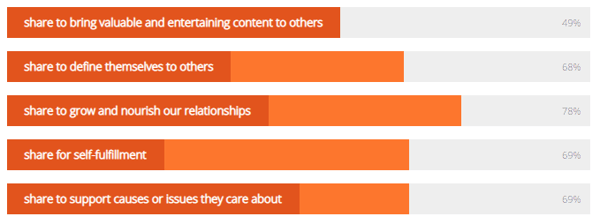Social Media Marketing, The Ins and Outs
Social Media is a fickle beast, and in this world of big data how much information are we sharing on a daily basis? How does Social Media play a factor in my business? How does my marketing strategy fit with Social Media?
These are just some the questions I'm asked frequently about at Chirp Media, Inc. from prospective clients, in today's post we are going to cover the topic of social media marketing and to top it off, we've got another freebie for you. We are offering you a Free Social Media Marketing Consult, which is a $1000 value, all you need to do is fill out the survey at the end of the post and we'll get it set right up.
What is Social Media Marketing
Social media marketing is a form of internet marketing, utilizing social networking sites like Facebook, Twitter and the rest as a marketing tool. Typically social media marketing involves business producing and curating content that will cause users to engage and share with their friends, primarily with the aim of driving traffic to that business' website, increasing brand exposure and extending it's customer reach.
How does Social Media Work in Business
So we've build down what it is, but how does this work in business? People will typically search for a product online or go into your store, or even look up your business right? Well social media can play a big factor in that. Think of social media users as your unofficial sales force, as people talk and comment about your product or service they are engaging others and giving them the down low, even if it's bad news.
In the days before social media, if there was a person speaking negatively about your product they were telling one or two people, and those one or two people would tell another group, and it would trickle down from there. This did impact your business, but never in a pace as it would today. Users on social media have instant access to the world, and once they make a comment, it's out there and there is no turning back.
How do you combat this? Well it's not always bad, so maybe combat is not the right term. But social media definitely allows you to act quick, if managed, and respond while collecting feedback and making the situation better. The end goal is engagement, you want to be engaged with your existing client base while still reaching out to new prospects. If the new prospects see the negative feedback, but also see you are responding to it appropriately and it's not just out there sitting in the wind they will be more likely to do business with you.
Enough on the negatives for now though, let's focus on some positives. Remember the comment about immediate access? Well it's a plus as well, you can push content out immediately to existing and prospective clients. This is great! I remember in my days working with direct mail campaigns, they're not necessarily bad, but they did take a lot of work. Days if not weeks, and at times it was hard to track the ROI for clients. I'm not going to say it was impossible to track, as there were solutions we came up with.
An Example of the Old Ways
A simple DM campaign that I had worked on at one point, an event planner was hosting a workshop in a suburb of Calgary. She was just a startup so she didn't have a mailing list to send the notice out to, so we had to send the mail out to specific zones within Calgary. Let's breakdown the time frame from start of design to mail out:
- ~ 2 Weeks for Design Work
- ~ 1 Week to build a targeted mailing list (If we were doing Direct 1-1 Mail Campaigns allow for another week if the list doesn't exist already)
- ~ 1 Week to have print pieces prepared
- ~ 1 - 3 days to print variable address data onto printed pieces (if not directly printed)
- Then depending on Geography and where you were mailing out, well that's up to the postal system
Right there we are looking at almost a month to spread the word about an event, happening locally in a specific area of Calgary, targeting a specific demographic. Also note, that we did an e-mail campaign as well targeting existing clients she had. In the end, she had success with her event, but altogether the time involved in this method was outrageous in comparison had social media been a factor when we worked on the project.
Today's Alternative
She could have easily used Twitter and Facebook, to blast out information about her event, and added it to Social Event networks like Eventbrite. Allow her to focus more energy and time on the content of her workshop. She could have started creating articles and posts leading up to her event to share on social media and her website which would of engaged users and gotten a more immediate response to how the event could unfold.
To sum up how social media works in Business, would be to simply state that integration is immediate. You can track how your audience engagement is doing almost in real-time and pivot your priorities as needed. Remember that content is king, you need to ensure what you are offering is compelling enough to the audience that they act on it, or at the least revisit it once and a while. With 2 out 3 people using at least one social media network, it allows business to maximize their opportunities to be found by their target audience. But, as your content is essential to your success, SEO still plays a huge part. People need to be able to find your content, read another article we wrote about this topic: The Importance of SEO and a Freebie!
Social Media Marketing + SEO
Social media marketing and SEO, in short are related. As the internet develops and new networks become available this is becoming more relevant. Content is being produced at a rate so fast, that the importance of quality content is increasing, and with that Search Engines are altering their algorithms and Search Engine Result Pages to accommodate.
Here is a quick break down on some stats on the subject:
- The average American consumes 34 gigabytes of content and 100,000 words of information in a single day
- Every 2 Days We Create As Much Information As We Did Up To 2003
- Facebook users share nearly 2.5 million pieces of content a minute
- 500 million Tweets are sent out in a day
As we produce more and more content, search engines need to become more intelligent and sophisticated with how they rank content so that users get the best possible results for their search queries. Since the average person is utilizing at least one social media network, and these sites are showing how people show interest in content through likes and shares, search engines have started incorporating these signals into a metric for ranking web pages.
In correlation to content being posted on top ranking Google Search Result Pages, below we find the average share percentage per social network

Source: Search Metrics 2015 Correlation Study
While the topics seem like to separate ideas, it is important to remember that they are becoming more directly related everyday.
The Right Platform
Each social media network is different, they all have different focus' and purposes for content discovery and publishing. The trick is finding which platform is best suited for your business' needs. It's simple enough to have an account on all social media networks, but is that really effective for your social media marketing? There are three questions I like to get clients to ponder when we discuss social media:
- What do you want to gain from being on social media?
- What social media websites tend to work well for similar businesses in your industry?
- Who are my target customers, and what social media platforms are they most likely to occupy?
Once a well thought out answer to each question has been established, researching the right platform for your needs becomes an easy task. Think of it like buying a car;
- What car will get me the most mileage?
- Are their similar models from other manufacturers that offer lower prices?
- Does it come in gold?
Alright so that last one isn't really a question most find themselves asking, but it's definitely one to think about.
The all important Share
Recently the New York Times Custom Insight Group created a document entitled The Psychology of Sharing, which reveals the 4 main reasons why people share content. It is an interesting read, but we've summed up the details here.

What to Share
There really is no rules in terms of what to share, in reality you can share whatever you like. We try to preach that sharing anything is good; wether that is your own content, or curated content from multiple sources.
There is however a popular ratio floating out there that some of you may have heard of, the 5-3-2 Rule. It is summed up as every 10 pieces you share, 5 should be curated content from others (50%), 3 should be your own ( 30%) and 2 should be entertainment or personal content (20%). Sounds simple enough right? That is because it really is that simple.
The biggest pain points we have found from our clients are:
- The time investment to find and/or create content,
- The consistency in finding and/or creating content, and
- The value of the content
I could go on and on about the pain points above, but that's another article in its own. The best thing to consider, is that once a strategy is in place and the engine is running, this will all become second nature. I think the biggest quote I can repeat that I hear when talking about content curation,
"Oh my god, I have to go and look up interesting articles... I don't have that kind of time"
I typically laugh, and not because I'm cynical. It mainly relates to the fact that I have to ask
"How much time do you search the internet during the day when you say you're working?"
Or
"When you're at home, and reading news online or just browsing the web, what are you looking for?"
Those two questions right there, directly corollate with content curation. There are a ton of tools out there, that you can use to bookmark interesting websites and posts. Simply add 2 seconds to that process to bookmark it or share it right away! In the most average of cases, everyone is browsing the internet for about an hour at the minimum everyday. Think about the content you consumed in that time, and how much of it you can share without doing more than clicking share or like.
Curated Content - The 50%
As I noted above, curated content is content that you have found from another source. It could be within your industry, and article a friend sent you, anything really.
So why share content from others? Think about the conversations you have on a daily basis with friends, family, colleagues. Do you keep the content you consumed to yourself, or do you share that with others? Do you talk to others, or just yourself?
You typically will connect and discuss topics of similar interest, and have a good variety of those conversations through the course of the day. Social media is just another type of conversation, so it only makes sense to treat it the same way. People tire quickly of business that just talk about themselves and tend to strive away, just like we do in person-to-person communication. I know I don't like talking with people who can only tell me about them and have nothing else to say. So why would I want to only ready about what your company does and why it does it best?
Where can you find amazing content to share?
- Newsletters
- Social Media
- Scoopit/StumbleUpon
- Feedly
- Medium
- Monthly Roundups (some blogs compile lists of the best content from the month/week before that can give you some amazing things to share)
- Communities/Forums (Google+ have some amazing communities that regularly share really great content)
One of the biggest pieces here that you do want to try and remember is that content is still very important. It's relevance to the voice of your brand is of the upmost importance, so when sharing content on your business social media accounts, be sure it's relevant to your brand voice. Save some of the goofy stuff, like photo memes for your personal account. But, it is okay to have some fun once and a while, just be cautious of how your business is being represented.
Your Own Content - The 30%
Creating your own content can be hard, I know at Chirp Media, Inc. we still have issues sometimes trying to think of the next thing we want to talk about. But it's a process and we're working on it. Developing a content strategy is a great way to get started, along side some form of editorial schedule to maintain consistency. If you're on a small team, maybe workout a schedule were at least one person from the organization is creating a post about something in the industry. I'm sure there are a lot of topics your business' can discuss, that the outside consumer isn't well versed in and could be educated on.
Try to personalize what you are sharing, so that you don't come off as a robot. It's very important to try and make a connection with the reader. Go the extra mile, by adding imagery to your content for even more engagement.
Other Content - The 20 %
One of the most overlooked aspects about business use of social media is personalization and entertainment. Your brand voice should be humanized, if it's not there is no way a reader will connect and engage.
Think about sharing additional items you've found online, there are a lot of really cool tools out there, like MemeGenerators for specific industries. Inspiration quotes or tips of the day go a long way too.
Next Steps
There is a lot a business can learn about how to effectively utilize social media marketing in their business, and we've provided a lot of detail in this article to help you get started. On that note, Chirp Media, Inc. is currently conducting a survey to help understand where the knowledge is and isn't. It should only take you a few moments to fill out, and as a reward we are providing you with a Free Social Media Marketing Consult, typically a $1000 value. Sounds like a great deal, am I a right?
So without further ado, please click on the button below that will take you to our survey.
Article by Richard Walsh
As a certified inbound and content marketer, Richard believes in the need to create high-quality compelling content, that drives engagement and interaction. Richard has been developing brands and high-quality web experiences since 2001. Book a meeting with Richard to talk about your branding and marketing efforts.




